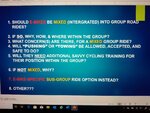Thinking here on what I've personally observed on how my ebike (like a trike or a "different" sort of bike) will make my ride stand out a bit from the crowd:
1. The cadence. It will be quickly noticed by others that the ebike rider's pedal stroke on average, by comparision, will be slower and less hurried than that of unassisted cyclists. The propensity of the e-cyclist to ride in a higher gear (due to the added assist by the motor) will look slightly out of place, and will absolutely make one (at first) be looked at not once, but several times, as the other riders try to see why "that person" is at a very visual low cadence while every one else seems to be at a higher cadence. It becomes almost "in your face" different from what can be considered a "normal pedal stroke " when ascending a hill. It WILL make the ebike stand out, like waving a red flag. This is when the word "cheating" or "cheater" seem to be uttered the most by the unassisted riders, and the time that the ebiker needs to be prepared for - with either a smile and nod or a non-confrontational explanation. The ebiker should understand that chances are 100% that they will stand out at some point during the ride, and not to take any disparaging remarks personally. A friendly smile and simply saying "its an ebike - it helps me keep cycling rather than standing in the sidelines, watching" is often the only explanation needed for an amicable understanding between riders to take place.
2. Your ebike will stand out in appearance. By default it will be much heavier looking in the frame than a nonassisted bike if the ebike is a manufactured PAS. A converted hub bike will be more stealth if the hub is small and the battery hidden. Either way, be prepared to field questions. On average most cyclists are very interested in the other bikes around them and often casual conversations are initiated regarding individual bikes and their advantages. The ebike - being the new kid on the block - will draw attention and sincere interest in both its performance and use. Answering questions in an informative, polite, and friendly way on how the bike works and what its performance capabilities do to help the rider achieve whatever goals were foremost when selecting the ebike for purchase, will go a long way in helping other riders see what an ebike can accomplish in regards to a rider that (oftentimes) can no longer ride without some outside assistance.
3. Acceptance. No one in a group cares what kind of bikes are ridden as long as the riders are polite and follow group cycling etiquette. The ebike tends to level the playing field nicely, but, like any other group activity, one may find they need to go slower, or faster, than their normal to maintain the integrity of the group. If it turns out the speed, or the chosen terrain/venue of the group ride is simply not to ones liking, it is best to accept the situation with good grace for the duration of the ride, and decide after the ride if it would be better to find a different group.
4. Range anxiety. It is a real thing, and will always be on the top of the priority list during any ride because while an ebike will absolutely level the playing field for its rider, it will only do so as long as the battery has the capacity to assist. It will be necessary for the e-cyclist to be very careful that the range of the assistance is well within the distance expected to be covered by the ride. To suddenly lose assistance due to a depleted battery, or a malfunction, can result in either the rider struggling to remain in the group, being dropped, or causing the group to have to stop more frequently for the disabled ebike to catch up. Thus, an e-cyclist should always plan for the worst "what if" scenario, and ways to mitigate problems that may arise. ALWAYS carry a map of the area. ALWAYS. If an extra battery can be carried, then do so for rides longer then 20 miles. Change out the first battery before it reaches its bottom, and try to do it as discretely, and seamlessly, as possible, preferably during a group rest stop or a water break. Stop at the back of the group, make the adjustment and/or swap quietly, and then carry on.
If the battery quits unexpectedly, and the rider finds they cannot keep up with the group without assistance, the polite thing to do is excuse oneself at the next rest stop and return to the group meeting place. Always ask if anyone else wishes to return, and don't be surprised if one or two other riders, for whatever reasons, wish to do so as well.
I'm sure I'll think of more later on, but these points all are part and parcel of what to expect when riding an ebike in a group, and all of them I have personally experienced in one way or another.






